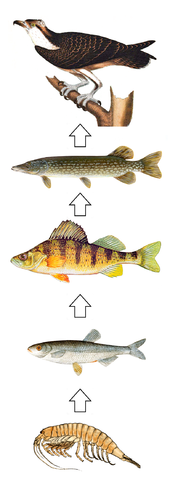
A food chain is a linear network of links in a food web, often starting with an autotroph (such as grass or algae), also called a producer, and typically ending at an apex predator (such as grizzly bears or killer whales), detritivore (such as earthworms and woodlice), or decomposer (such as fungi or bacteria). It is not the same as a food web. A food chain depicts relations between species based on what they consume for energy in trophic levels, and they are most commonly quantified in length: the number of links between a trophic consumer and the base of the chain.
Food chain studies play an important role in many biological studies.
Food chain stability is very important for the survival of most species. When only one element is removed from the food chain it can result in extinction or immense decreases of survival of a species. Many food chains and food webs contain a keystone species, a species that has a large impact on the surrounding environment and that can directly affect the food chain. If a keystone species is removed it can set the entire food chain off balance.[1]
The efficiency of a food chain depends on the energy first consumed by the primary producers.[2] This energy then moves through the trophic levels.
- ^ "The Food Chain". www2.nau.edu. Retrieved 2019-05-04.
- ^ Rowland, Freya E.; Bricker, Kelly J.; Vanni, Michael J.; González, María J. (2015-04-13). "Light and nutrients regulate energy transfer through benthic and pelagic food chains". Oikos. 124 (12). Nordic Foundation Oikos: 1648–1663. Bibcode:2015Oikos.124.1648R. doi:10.1111/oik.02106. ISSN 1600-0706. Retrieved 2019-10-25 – via ResearchGate.